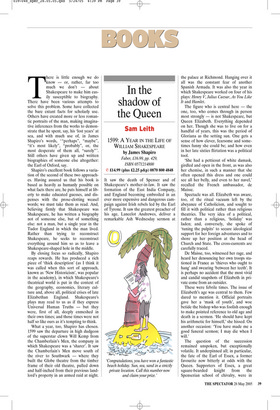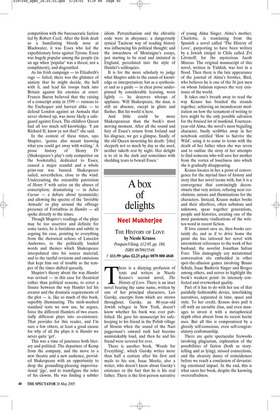In the shadow of the Queen
Sam Leith
1599: A YEAR IN THE LIFE OF WILLIAM SHAKESPEARE by James Shapiro Faber, £16.99, pp. 429, ISBN 0571214800 ✆ £14.99 (plus £2.25 p&p) 0870 800 4848 There is little enough we do know — or, rather, far too much we don’t — about Shakespeare to make him easily susceptible to biography. There have been various attempts to solve this problem. Some have collected the bare extant facts for scholarly use. Others have created more or less romantic portraits of the man, making imaginative inferences from the works to demonstrate that he spent, say, his ‘lost years’ at sea, and with much use of, in James Shapiro’s words, ‘“perhaps”, “maybe”, “it’s most likely”, “probably”, or, the most desperate of them all, “surely”’. Still others have given up and written biographies of someone else altogether: the Earl of Oxford, say.
Shapiro’s excellent book follows a variation of the second of these two approaches. Having assured us that his book is based as heavily as humanly possible on what facts there are, he puts himself at liberty to make educated guesses, and dispenses with the prose-clotting weasel words; we must take them as read. And, believing firmly that Shakespeare was Shakespeare, he has written a biography not of someone else, but of something else: not a man, but a single year in the Tudor England in which the man lived. Rather than trying to reconstruct Shakespeare, he seeks to reconstruct everything around him so as to leave a Shakespeare-shaped hole in the middle.
By closing focus so radically, Shapiro reaps rewards. He has produced a rich piece of ‘thick description’ (as I think it was called when this sort of approach, known as ‘New Historicism’, was popular in the academy), in which Shakespeare's theatrical world is put in the context of the geography, economics, literary culture and, above all, political crises of late Elizabethan England. Shakespeare's plays may read to us as if they express Universal Human Truths — but they were, first of all, deeply enmeshed in their own times; and those times were not half so like ours as it’s tempting to think.
What a year, too, Shapiro has chosen. 1599 saw the departure in high dudgeon of the superstar clown Will Kemp from the Chamberlain’s Men, the company in which Shakespeare was a ‘sharer’. It saw the Chamberlain’s Men move south of the river to Southwark — where they built the Globe theatre from the timber frame of their old theatre, pulled down and half-inched from their previous landlord’s property in an armed raid at night. It saw the death of Spenser and of Shakespeare’s mother-in-law. It saw the formation of the East India Company, and England becoming embroiled in an ever more expensive and dangerous campaign against Irish rebels led by the Earl of Tyrone. It saw the greatest preacher of his age, Lancelot Andrewes, deliver a remarkable Ash Wednesday sermon at the palace at Richmond. Hanging over it all was the constant fear of another Spanish Armada. It was also the year in which Shakespeare worked on four of his plays: Henry V, Julius Caesar, As You Like It and Hamlet.
The figure who is central here — the one, too, who comes through in person most strongly — is not Shakespeare, but Queen Elizabeth. Everything depended on her. Though she was to live on for a handful of years, this was the period of Gloriana as the setting sun. One gets a sense of how clever, fearsome and sometimes funny she could be; and how even in her late sixties flirtation was a political tool.
‘She had a petticoat of white damask, girdled and open in the front, as was also her chemise, in such a manner that she often opened this dress and one could see all her belly, and even to her navel,’ recalled the French ambassador, de Maisse.
Spectacle was all. Elizabeth was aware, too, of the ritual vacuum left by the abeyance of Catholicism, and sought to fill it with political rather than religious theatrics. The very idea of a political, rather than a religious, ‘holiday’ was laden; and, conversely, she spoke of ‘tuning the pulpits’ to secure ideological support for her foreign adventures and to shore up her position at the head of Church and State. The cross-currents are carefully traced.
De Maisse, too, witnessed her rage, and heard her denouncing her own troops stationed in France as ‘thieves who ought to hang’ and swearing ‘between her teeth’. It is perhaps no accident that the most vivid and candid snapshots of Elizabeth in private come from an outsider.
These were febrile times. The issue of Elizabeth’s age was central to them. Few dared to mention it. Official portraits gave her a ‘mask of youth’, and woe betide the bishop who was foolish enough to make pointed reference to old age and death in a sermon. ‘He should have kept his arithmetic for himself,’ she hissed. On another occasion: ‘You have made me a good funeral sermon; I may die when I will.’ The question of the succession remained unspoken, but exceptionally volatile. It underpinned all; in particular, the fate of the Earl of Essex, a former favourite now bitterly at odds with the Queen. Supporters of Essex, a great square-bearded knight from the Spenserian school of chivalry, were in competition with the bureaucratic faction led by Robert Cecil. After the Irish dealt us a humiliating bloody nose at Blackwater, it was Essex who led the expeditionary force against Tyrone. Essex was hugely popular among the people (in an age when ‘popular’ was a threat, not a compliment), and disgruntled.
As his Irish campaign — to Elizabeth's rage — failed, there was the glimmer of anxiety that he might decide, the hell with it, and lead his troops back into Britain against his enemies at court. Francis Bacon believed that the raising of a conscript army in 1599 — ruinous to the Exchequer and harvest alike — to defend London against an Armada that never showed up, was more likely a safeguard against Essex. The childless Queen had all too much self-knowledge. ‘I am Richard II, know ye not that?’ she said.
In the context of these times, says Shapiro, ‘genius also meant knowing what you could get away with writing.’ A prose history of Henry IV (Shakespeare’s play’s only competitor on the bookstalls), dedicated to Essex, caused a major scandal and a whole print-run was burned. Shakespeare sailed, nevertheless, close to the wind. Undercutting the ostensible patriotism of Henry V with satire on the abuses of conscription; dramatising — in Julius Caesar — a debate about tyrannicide; and allowing the spectre of the ‘Invisible Armada’ to play around the offstage presence of Fortinbras in Hamlet — all spoke directly to the times.
Though Shapiro’s readings of the plays may be too assertive and definite for some tastes, he is fastidious and subtle in arguing his case, pointing to everything from the rhetorical echoes of Lancelot Andrewes, to the politically loaded words and themes which Shakespeare interpolated into his source material, and to the tactful revisions and omissions that kept him out of trouble as the temper of the times shifted queasily.
Shapiro’s theory about the way Hamlet was revised — in this case for theatrical rather than political reasons, to cover a fissure between the way Hamlet led his creator and the dramatic requirements of the plot — is, like so much of this book, superbly illuminating. The mish-mashed standard texts we now use, he argues, force the different Hamlets of two essentially different plays into co-existence. That provides for this reader, and I’m sure a few others, at least a good excuse for why of all the plays it is Hamlet we never quite ‘get’.
This was a time of junctures both literary and political. The departure of Kemp from the company, and the move to a new theatre and a new audience, provided Shakespeare with an opportunity to drop the groundling-pleasing improvisational ‘jigs’, and to transfigure the roles of his clowns. He was finding a subtler idiom. Petrarchanism and the chivalric code were in abeyance; a dangerously cynical Tacitean way of reading history was influencing his political thought; and the inwardness of Montaigne’s essays, just starting to be read and imitated in England, percolated into the style of Hamlet’s soliloquies.
It is for the more scholarly to judge what Shapiro adds to the canon of knowledge or interpretation; but as a synthesiser and as a guide — in clear prose underpinned by considerable learning, worn lightly — he deserves whoops of applause. Will Shakespeare, the man, is still an absence, except in glints and flashes. But his world is here.
And little could be more Shakespearean than the book’s most moving moment. After all the sound and fury of Essex’s return from Ireland and his disgrace, we get a glimpse, finally, of the old Queen mourning his death: ‘[she] sleepeth not so much by day as she used, neither taketh rest by night. Her delight is to sit in the dark and sometimes with shedding tears to bewail Essex.’























































 Previous page
Previous page